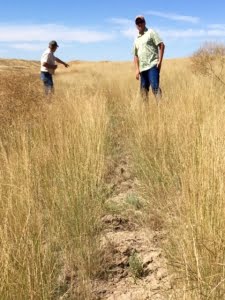
Planting Plans for Washington State SPP Sagebrush
Aug 3rd , 2016 — Twenty thousand inmate-grown Wyoming sagebrush plants will be planted in the Swanson Lake Wildlife Refuge area fall of 2016. Bureau of Land Management (BLM) and Washington Department of Fish and Wildlife (WDFW) have been working together for years to manage adjacent parcels of land for wildlife habitat. Specifically, for Greater Sage Grouse and Sharp-Tailed Grouse. Coyote Ridge Correction Center (CRCC) Sagebrush Steppe Conservation Project is part of the greater Sustainability in Prisons Project (SPP). Institute for Applied Ecology (IAE) works closely with the Department of Corrections (DOC), BLM and the SPP network to grow genetically suitable sagebrush to plant after fires.
Both WDFW’s Juli Anderson and Mike Finch and BLM’s Jason Lowe gave Dorothy Trainer of DOC, and Gretchen Graber of IAE a superb tour of the 2016 planting sites. An inmate crew will be planting 15,000 plants by tractor planter while another 5000 will be hand-planted in 6 separate parcels. Clusters of eighty plants will eventually disperse seed into the surrounding landscape, essentially becoming their own regenerative hotspots. Cluster areas will be flagged by agency personnel prior to planting day. “Inmates want to do what has been asked and they feel more comfortable knowing they are planting in the correct location. This helps build confidence and they take pride in their work”, said Graber.

For monitoring purposes, the ‘corners’ of each cluster will be flagged. The land managers have requested this, which we feel is a great way to support their post-planting monitoring efforts.
Gretchen Graber and Juli Anderson, will direct the hand-planting areas: deliver boxes to pre-determined cluster areas and provide tools. Juli and Gretchen will lead a short planting training and continue to manage for quality control throughout the day.
Jason Lowe, Mike Finch and Dorothy Trainer will manage the tractor planting with an inmate crew of two. Twenty well-rooted sagebrush plants will be delivered in early October to test the tractor planter, which worked well last year.
Last year we had a 65 percent survival rate and we hope to increase that this year. This fall we are trying a new packaging technique called the ‘Jelly Roll’ where the plants will be de-potted at the nursery, wrapped in cellophane and rolled up in groups of 20. Bundling the plants into ‘Jelly Rolls’ decreases moisture loss during transport, as well as lessening the possibility of damage to the root ball when being removed from the pot in the field. Other benefits include not having to return the pots to the nursery after being transplanted and less cumbersome transport in the field. This technique saves time in the field, with the additional benefits of increasing sagebrush survival rates.
-Photos and article by Gretchen Graber
